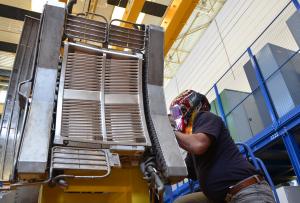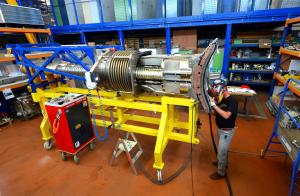In tokamaks, the technique most generally implemented is based on radio frequency (RF) waves, similar to the "waves" that carry radio programs over long distances.
But whereas the non-stop broadcasting of news or music from one end of a continent to another only requires a few dozen kilowatts of power, heating a plasma just a few centimetres away demands several megawatts.
In both cases, an antenna does the delivering: a thin metallic structure for radio; a massive, more complex antenna for plasma.
A few hundred metres from the ITER site, in a workshop near the tokamak
WEST (the former Tore Supra, now equipped with an ITER-like divertor) such an antenna is in the last stages of assembly.
The 4.5-metre-long, three-tonne component is one of three identical antennas that will deliver radio waves into the plasma. Together, they form the ion cyclotron resonance heating system (ICRH), which, along with two lower hybrid¹ antennas, will heat WEST plasmas.
"The objective is to heat the plasma in order to deposit an ITER-relevant heat load of 10 MW per square metre² on WEST's tungsten divertor," explains Jean-Michel Bernard, the head of the Plasma Heating Group at the French Institute for Magnetic Fusion Research (IRFM).
Although the antenna itself is not "ITER-like," the heat load and the tungsten divertor are—once fully equipped with its heating system WEST will be an important test bench and risk limiter for ITER.
WEST's ICRH antennas were designed by engineers of the French Alternative Energies and Atomic Energy Commission (CEA) within the framework of a European collaboration with Belgium, Germany and Italy. Most of the antenna elements were produced by the Institute of Plasma Physics (ASIPP) in China as part of a collaboration initiated in 2013.
The antenna design draws a lot (and cannibalizes a few parts) from the "ancestors" that operated for more than 20 years in Tore Supra.
There are however two major differences. The first is related to ELMs—those bursts of energy and particles that are akin to solar eruptions and can represent 5 to 10 percent of the total energy stored in a fusion plasma.
For reasons that have to do with plasma shape and operational regime, ELMs did not occur in Tore Supra. They will, however, occur in WEST, causing sudden heat loads and variations in the density of the plasma—a phenomenon that will reduce the efficiency of the radiofrequency power coupling and can threaten the integrity of the system.



